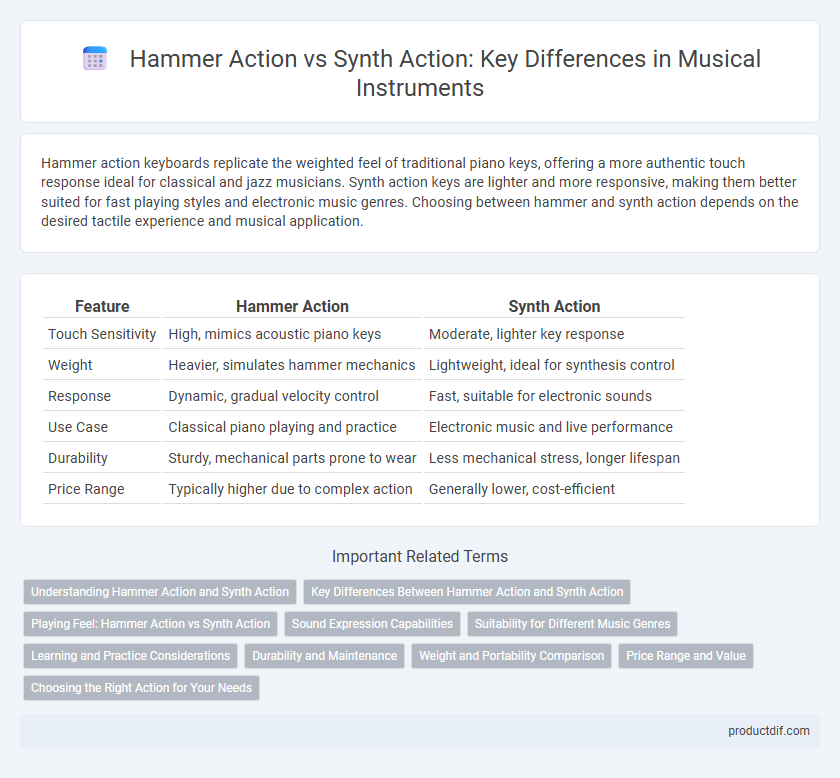Hammer action keyboards replicate the weighted feel of traditional piano keys, offering a more authentic touch response ideal for classical and jazz musicians. Synth action keys are lighter and more responsive, making them better suited for fast playing styles and electronic music genres. Choosing between hammer and synth action depends on the desired tactile experience and musical application.
Table of Comparison
| Feature | Hammer Action | Synth Action |
|---|---|---|
| Touch Sensitivity | High, mimics acoustic piano keys | Moderate, lighter key response |
| Weight | Heavier, simulates hammer mechanics | Lightweight, ideal for synthesis control |
| Response | Dynamic, gradual velocity control | Fast, suitable for electronic sounds |
| Use Case | Classical piano playing and practice | Electronic music and live performance |
| Durability | Sturdy, mechanical parts prone to wear | Less mechanical stress, longer lifespan |
| Price Range | Typically higher due to complex action | Generally lower, cost-efficient |
Understanding Hammer Action and Synth Action
Hammer action mimics the weighted keys of an acoustic piano, providing realistic touch response and dynamic control essential for expressive performances. Synth action features lighter, faster keys ideal for electronic music creation, offering increased agility and rapid note repetition. Understanding these differences helps musicians choose the appropriate instrument based on playing style and genre preferences.
Key Differences Between Hammer Action and Synth Action
Hammer action mimics the weighted key response of an acoustic piano, providing a heavier, more tactile feel ideal for classical techniques. Synth action features lighter, spring-loaded keys that allow for faster playing and greater dynamic control, preferred in electronic music styles. The key differences lie in the feel and responsiveness, with hammer action emphasizing realism and synth action prioritizing speed and expressiveness.
Playing Feel: Hammer Action vs Synth Action
Hammer action keyboards replicate the weighted feel of traditional piano keys, providing a tactile resistance that enhances expressive playing and dynamic control. Synth action keys are lighter and more responsive, allowing for faster note repetition and ease in playing complex synth sounds or electronic music styles. Musicians seeking authentic piano touch prefer hammer action, while those prioritizing speed and electronic versatility lean towards synth action.
Sound Expression Capabilities
Hammer action keyboards replicate the feel of an acoustic piano with weighted keys that deliver nuanced dynamics and expressive control, enhancing sound articulation. Synth action keyboards feature lighter, unweighted keys that facilitate faster playing and easier execution of complex passages but may offer less tactile feedback for nuanced expression. The choice between hammer action and synth action significantly impacts a musician's ability to convey emotion and dynamic range in performance.
Suitability for Different Music Genres
Hammer action keyboards emulate the weighted feel of acoustic pianos, making them ideal for classical, jazz, and genres requiring expressive dynamics and nuanced touch. Synth action keyboards feature lighter, faster keys suited for electronic, pop, and genres emphasizing rapid note repetition and modulation. Musicians often choose hammer action for authentic piano techniques, while synth action supports versatile sound design and fast performance styles.
Learning and Practice Considerations
Hammer action keyboards replicate the weighted feel of acoustic piano keys, offering better finger strength development and dynamic control during practice. Synth action keys are lighter and more responsive, facilitating speed and technical agility but may lack the tactile feedback necessary for mastering traditional piano techniques. Choosing hammer action supports foundational skills essential for classical training, while synth action suits electronic music production and rapid note repetition.
Durability and Maintenance
Hammer action keyboards feature robust mechanical components designed to mimic the feel of an acoustic piano, offering superior durability under heavy use but requiring occasional tuning and maintenance of the weighted hammers. Synth action keyboards utilize lighter, spring-loaded keys that demand less maintenance due to fewer moving parts but may experience faster wear in the key mechanisms over time. Evaluating durability and maintenance costs, hammer action is preferred for long-term reliability in professional settings, while synth action suits casual use with minimal upkeep.
Weight and Portability Comparison
Hammer action keyboards replicate the weighted feel of traditional pianos, providing a heavier touch ideal for dynamic control and expressive playing, but this often results in greater weight and reduced portability. Synth action keyboards use lighter, spring-loaded keys that facilitate faster playing and increased portability, making them suitable for gigging musicians who prioritize ease of transport. Comparing the two, hammer action instruments tend to be bulkier and less convenient to carry, while synth action models strike a balance between playability and lightweight design.
Price Range and Value
Hammer action keyboards typically range from $300 to $2,500, offering authentic piano feel and superior build quality, ideal for serious pianists seeking expressive control and durability. Synth action keyboards, generally priced between $100 and $1,200, provide lightweight keybeds with faster response, appealing to beginners and electronic musicians prioritizing versatility and portability. The value of hammer action lies in its realistic touch and resistance, while synth action maximizes affordability and varied sound capabilities.
Choosing the Right Action for Your Needs
Hammer action keyboards replicate the weighted feel of traditional pianos, providing authentic tactile feedback essential for classical pianists and dynamic expression. Synth action keyboards feature lighter, spring-loaded keys that enable faster playing and are ideal for genres requiring rapid note repetition or electronic sound modulation. Selecting the right action depends on your musical style, technique preference, and performance goals to ensure optimal playability and comfort.
hammer action vs synth action Infographic

 productdif.com
productdif.com